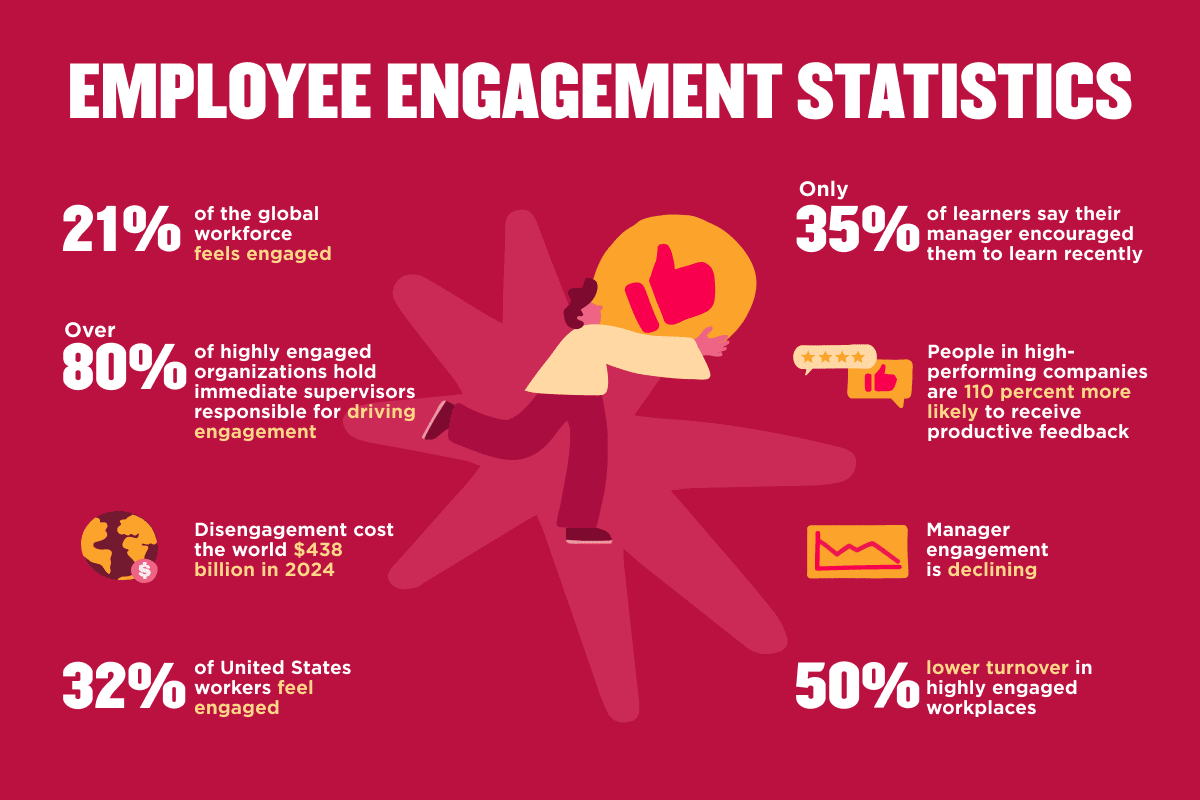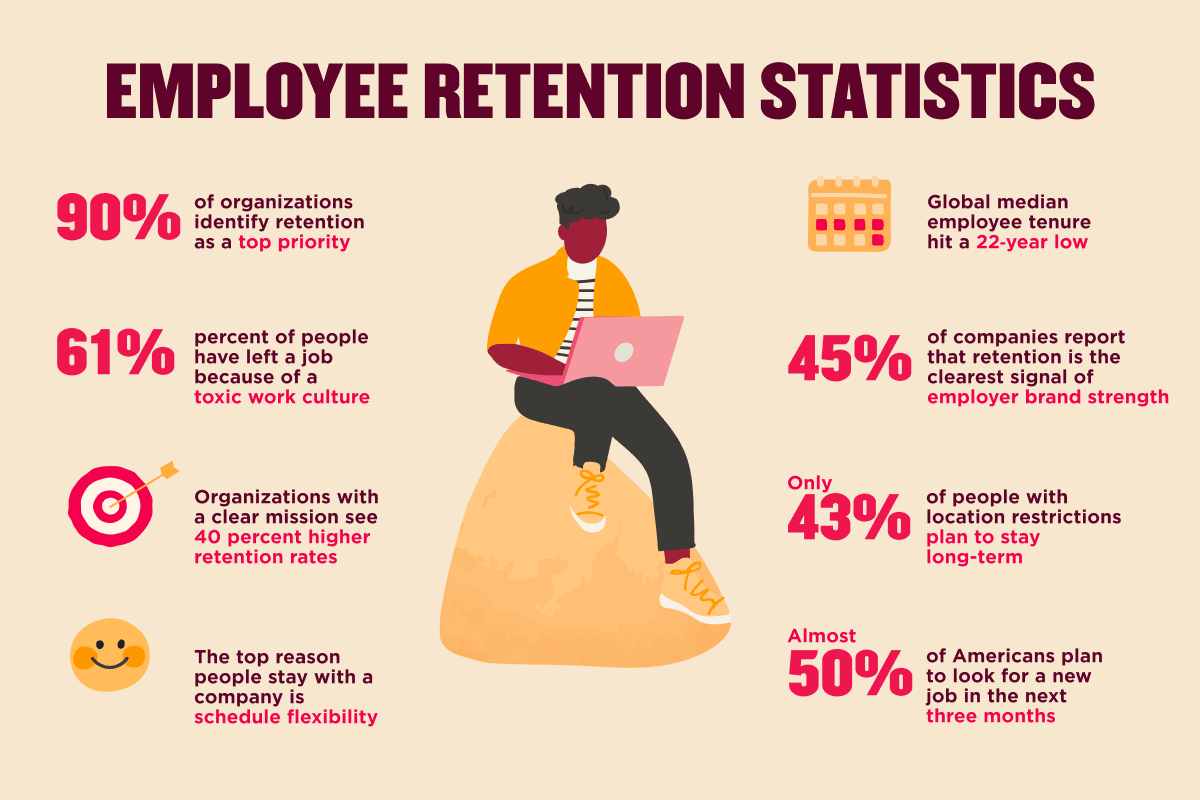Companies that prioritize keeping their people motivated, connected, and committed see the benefits: stronger performance, longer tenure, and a more resilient culture. For HR leaders, the opportunity lies in turning that focus into action. Having access to the right data helps pinpoint where efforts are most effective.
This guide shares essential statistics on employee engagement and retention—showing what drives loyalty, what affects productivity, and where HR teams can have the greatest impact. You’ll find insights that support smarter decision-making and stronger, more connected teams.
What is employee engagement?
Employee engagement refers to a professional’s motivation and commitment to perform high-quality work and contribute to company success. Engaged people align themselves with company goals, contribute with energy, and experience a stronger sense of wellbeing—ultimately leading to higher satisfaction and stronger retention.
Organizations can measure engagement in different ways. They use surveys and stay interviews to capture direct feedback, analyze data on turnover and absenteeism, and track signs of disengagement like missed goals or low participation. Together, these insights show how connected teams feel and where HR can take action to improve motivation.
What is employee retention?
Employee retention refers to the percentage of people who remain at a company over time. High retention indicates that people feel engaged, supported, and motivated to grow, while low retention often suggests deeper cultural or operational issues.
Tracking retention rates helps organizations identify risks, adjust policies, and strengthen long-term stability.

Employee engagement statistics
Engagement is a measurable driver of performance, wellbeing, and retention. However, global engagement levels continue to fall—and the impact on productivity and morale is serious. For HR and people teams, this means turning insights into action: aligning goals, empowering managers, and embedding engagement into daily workflows. These statistics reveal what engagement looks like today and how leadership, feedback, learning, and tools can help teams stay connected and motivated.
1. Only 21 percent of the global workforce feels engaged.
Global engagement dropped from 23 percent to 21 percent in 2024, reflecting the largest decline since the pandemic. Gallup identifies this as a major setback, since team member engagement influences productivity, wellbeing, and economic growth worldwide. Organizations that fail to address this risk reduced growth and higher turnover.
Recommended For Further Reading
2. About a third of United States workers feel engaged.
Engagement in the United States dropped slightly to 32 percent in 2024, one point lower than the year before. While this remains higher than the global average, the decline can signal a need for renewed focus on how organizations support their people.
HR leaders can respond by focusing on manager development, since leaders play the largest role in driving engagement. Expanding recognition programs and offering career growth opportunities also help maintain a stronger commitment across teams.
3. Disengagement cost the world $438 billion in 2024.
Declining engagement drained $438 billion from the global economy in 2024. HR teams can tie engagement directly to business metrics like absenteeism, productivity, and turnover. Spotting early warning signs, like missed goals or declining participation, gives leaders the chance to act fast, re-engage their teams, and protect long-term performance.
4. Manager engagement is declining.
Manager engagement declined from 30 percent to 27 percent in 2024. Older managers also experienced a 5 percent drop in wellbeing over the past year, and female managers saw a 7 percent decline. Since managers’ communication style and support directly influence motivation and satisfaction, these trends explain why overall employee engagement has decreased over the past year.
5. Only 35 percent of learners say their manager encouraged them to learn recently.
According to LinkedIn’s 2023 Workplace Learning study, less than four in ten team members felt direct encouragement from managers to pursue development in the past six months. This signals a missed opportunity to build engagement, boost motivation, and retain growth-minded professionals.
Companies can close this gap by training managers to hold regular career conversations, recommend relevant learning paths, and connect upskilling to long-term goals. When learning feels personal and supported, people are more likely to stay—and grow.
6. People in high-performing companies are 110 percent more likely to receive productive feedback.
Helpful feedback fuels engagement and performance by being timely, specific, and focused on growth—not just evaluation.
To build this kind of culture, companies can train managers to give feedback regularly, not just during performance reviews. Embedding feedback into one-on-ones, project debriefs, and development check-ins helps people feel seen and supported.
<< Improve feedback with these free performance review templates. >>
7. Over 80 percent of highly engaged organizations hold immediate supervisors responsible for driving engagement.
According to WorkTango’s 2023 study, 84 percent of highly engaged organizations hold managers accountable for engagement—compared to just 53 percent in less engaged ones. This reflects a growing shift: engagement isn’t just an HR initiative, it’s a shared responsibility, and managers play a central role.
To put this into action, organizations can set clear expectations for managers around engagement, build it into performance goals, and provide the tools they need to lead meaningful one-on-ones, offer recognition, and support team development. When managers take ownership—and are equipped to follow through—engagement becomes part of everyday leadership, not just a quarterly metric.
8. Engagement reduces turnover by over 50 percent.
High engagement can cut turnover by 51 percent–a powerful reminder that keeping people connected and motivated directly protects your talent pipeline. Engaged team members are more likely to stay, perform at a higher level, and advocate for your company culture.
For HR leaders, this means making engagement a core part of business strategy—not just an HR initiative. Start by listening closely through pulse surveys, encouraging frequent manager check-ins, and building recognition into daily workflows. When engagement becomes embedded in how teams work, retention improves naturally and sustainably.

Employee retention statistics
Retention is about creating an environment where people want to stay. While the reasons for staying vary, some patterns are clear: flexibility, fair pay, meaningful work, and growth matter.
Retention is also a valuable lens into hiring effectiveness, onboarding quality, and leadership strength. These statistics explore what drives loyalty and how HR leaders can build cultures of trust, support, and long-term growth.
1. Retention remains a top priority.
A study published in 2024 reports that about 90 percent of organizations identify retention as a significant focus—and for good reason. High turnover disrupts teams, slows progress, and drives up hiring costs. To retain top talent, leaders need to go beyond surface-level fixes and invest in what truly matters to their people.
Start by mapping clear growth paths, ensuring compensation is fair and transparent, and recognizing contributions. Regular stay interviews, strong onboarding, and internal mobility programs can also strengthen long-term commitment. When people see a future at your company, they’re more likely to stay and grow with you.
2. Toxic work cultures drives attrition.
According to a 2023 survey, 61 percent of employees have left a job because of a toxic work culture. Disrespect, unethical behavior, and lack of inclusion undermine retention.
For HR and people leaders, this is a clear call to action: culture isn’t just a “nice to have”—it’s a business-critical factor in retention. Building an inclusive, respectful, and values-aligned environment is one of the most effective strategies for keeping top talent engaged long term.
3. Mission-driven companies retain more people by 40 percent.
Organizations with a clear mission see 40 percent higher retention rates. Out of 59 factors studied in 2024, purpose had the strongest link to retention—making people 2.7 times more likely to stay. Feeling proud of their work made them 2.2 times more likely, and enjoying their day-to-day role increased the likelihood by 1.7 times.
To put this into practice, HR leaders can align company values with day-to-day operations, highlight impact stories during onboarding and all-hands meetings, and encourage managers to connect team goals to the broader mission. When people see how their work matters, motivation and loyalty grow.
4. Schedule flexibility, compensation, culture, and career growth impact retention and turnover.
In 2025, the top reasons people stay with a company include schedule flexibility (15 percent), competitive pay and benefits (14 percent), and a positive workplace culture (14 percent). Meanwhile, common reasons for leaving include the opportunity for better pay (23 percent), more flexible schedules (15 percent), and clearer career growth paths (14 percent).
For HR leaders, these insights highlight where to focus: benchmark compensation regularly, expand flexible work options where possible, and make career development visible and accessible. Back these efforts with strong communication, recognition, and a culture that supports belonging. When people feel supported and see room to grow, they’re far more likely to stay engaged and committed.
5. Global median employee tenure hit a 22‑year low.
According to the U.S. Bureau of Labor Statistics, in January 2024, the median tenure dropped to 3.9 years—the lowest it’s been since 2002. While shorter tenure can reflect a more dynamic job market, it also signals a shift in how people view long-term commitment. Professionals are more willing to move on when their expectations around growth, culture, or flexibility aren’t met.
For HR and people teams, this reinforces the importance of intentional retention strategies. Start with onboarding, make it meaningful, not just administrative, and continue with regular career check-ins, clear mobility pathways, and open conversations about goals. When people see a future at your company, they’re more likely to stay and contribute over time.
6. Employers use retention rates to gauge the strength of their employer brand.
In 2024, 45 percent of companies report that retention is the clearest signal of employer brand strength. Companies that showcase a positive workplace culture, respond to team member feedback, and focus on team members’ experiences help build trust and keep people committed.
To build and communicate a strong employer brand, companies can spotlight real team member stories on career pages, social media, and during onboarding. Internally, share wins, highlight values in action, and regularly gather and act on feedback to show that the brand isn’t just a message—it’s a lived experience. When people see your culture in action and feel connected to the mission, it builds trust, loyalty, and long-term commitment.
7. Only 43 percent of people with location restrictions plan to stay long-term.
Retention improves when people have a say in where they work. In 2024, just 43 percent of team members with fixed work locations plan to stay long term, compared to 60 percent of those with flexible options.
While not every role or organization can offer full flexibility, HR leaders can still support retention by offering meaningful alternatives—like commuter benefits, wellness programs, or extra paid time off. What matters most is showing people that their time and wellbeing are valued, even when flexibility isn’t possible.
8. Almost 50 percent of Americans plan to look for a new job in the next three months.
Nearly half of U.S. workers in 2024 plan to search for a new job within three months. This level of turnover intent disrupts workforce planning and inflates hiring costs. To respond proactively, managers can hold regular stay interviews to understand what people value—and what might cause them to leave. These one-on-one conversations are a chance to build trust, uncover concerns early, and show a genuine interest in each team member’s experience.
To make stay interviews effective, managers should keep the tone informal and focused on listening. Ask open-ended questions like:
- What keeps you here?
- What part of your work feels most meaningful?
- Where do you feel blocked or unsupported?
- What would make your experience even better?
- Have you thought about leaving—and if so, what triggered that feeling?
Follow up by acknowledging the feedback, taking visible action where possible, and sharing progress across the team.

HR and people strategies for improving engagement and retention
As retention and engagement become business imperatives, people teams are stepping up with targeted programs that make a real difference. From DEI&B (diversity, equity, inclusion, and belonging) and recognition to learning, onboarding, and compensation strategies, today’s HR teams are moving beyond reactive solutions.
These statistics highlight how leading organizations can put people-first practices into motion—and where others can follow to boost connection, performance, and loyalty.
1. Around 41 percent of organizations use DE&I programs to strengthen engagement.
Inclusion programs support retention and strengthen engagement by ensuring people feel valued and heard. LinkedIn’s 2023 survey found that companies that encourage diversity and equity create environments where people can contribute more openly and even see stronger decision-making, higher innovation, and improved satisfaction. HR leaders can reinforce this by expanding resource groups, promoting inclusive leadership training, and enforcing pay equity.
<< Download this free pay equity template to get started. >>
2. Recognition directly drives retention.
As of 2025, about 71 percent of people say frequent recognition would make them less likely to leave their current role. Recognition holds weight equal to pay or career growth because it makes people feel visible and valued. Leaders can build weekly recognition into the culture through peer shoutouts, manager praise tied to core values, and public recognition dashboards.
3. Career progression remains a top reason why people leave.
In exit interviews across more than 20,000 cases, Work Institute’s 2024 Retention Report found that lack of career growth is still one of the leading drivers of turnover. When people can’t see a path forward, they’re far more likely to look elsewhere—regardless of how strong the culture or compensation may be.
For HR leaders, this is a call to prioritize internal mobility and career development. Map out growth paths across departments, encourage managers to have regular development conversations, and make open roles visible internally before looking outside. Back this with learning opportunities, mentorship programs, and recognition for skills-based progress—not just promotions. When people see they can grow where they are, they’re more likely to stay and invest in their future with the company.
4. Executives say HR is more critical than ever.
In 2023, about 82 percent of executives worldwide recognize that people strategy now sits at the core of business success. This shift gives HR leaders greater influence than ever before and highlights the need to prioritize engagement alongside traditional performance metrics.
HR leaders can use this visibility to secure investment in engagement by tying people initiatives directly to business outcomes. Frame engagement as a driver of productivity, customer satisfaction, innovation, and agility—not just an HR metric. Share data and stories that connect engagement efforts to reduced turnover, higher performance, and stronger culture. When HR speaks the language of business impact, it becomes a true strategic partner at the board level.
Employee engagement and retention: The key to business success
Engagement and retention don’t happen by chance—they increase when people feel consistently valued, supported, and connected to their work. Recognition, career development, and flexibility are essential building blocks, but it’s the daily actions of leaders that turn those efforts into long-term loyalty.
A clear retention strategy doesn’t just reduce costs—it strengthens trust, encourages collaboration, and fuels high-performing teams. Organizations that prioritize engagement today build cultures where people thrive—and gain a competitive edge for the future.
<< Successfully retain and engage your people with this employee retention plan template. >>


